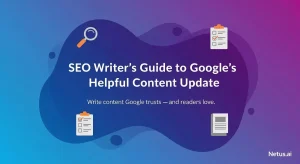
Google’s Helpful Content Update: An SEO Writer’s Guide | NetusAI
SEO Writer’s Guide to Google’s Helpful Content Update Keeping up with Google’s algorithm changes can feel like a relentless game of whack-a-mole. Just when you

Content writer and editor for Netus.AI
My Content Was Detected by AI. AI content detection has become increasingly prevalent in recent years, with more and more companies and educational institutions utilizing these tools to ensure the authenticity and originality of digital content. However, for many individuals, receiving a notification that their content has been flagged by an AI detector can be a disconcerting experience.
Understanding AI content detection is crucial for anyone who creates digital content. AI detectors use advanced algorithms to analyze text and identify patterns that indicate the content may not be original or may have been generated by an AI program. While these tools are incredibly accurate, they are not infallible, and it is possible for legitimate content to be flagged by mistake.
Key Takeaways:
AI-generated content refers to any text, image, or video that is created by an artificial intelligence system. This type of content is becoming increasingly common as AI technology advances. AI-generated content is often used in areas such as product descriptions, news articles, and social media posts.
AI detectors are tools designed to detect when a text was partially or entirely generated by artificial intelligence. These tools are crucial in identifying and flagging AI-generated content, which can be used to deceive or manipulate readers. AI detectors employ Natural Language Processing (NLP) algorithms, linguistic analysis, and sentiment analysis to detect subtle anomalies and patterns that may suggest AI authorship.
The accuracy of AI detectors varies, and most are easy to trick. As AI tools improve, the line between human- and machine-generated text is blurring. It will become harder for AI detectors to distinguish between the two. Therefore, it is essential to continuously improve detection models to keep up with the advancements in AI technology.
In conclusion, AI-generated content and AI detectors play a significant role in the world of content creation. While AI-generated content can be useful in many contexts, it is essential to have reliable AI detectors to detect and flag any AI-generated content that may be used to deceive or manipulate readers. The accuracy of AI detectors is crucial, and it is essential to continuously improve detection models to keep up with the rapid advancements in AI technology.
AI detection tools use advanced algorithms and natural language processing (NLP) to differentiate between human-generated and AI-generated content. These technologies work together to analyze patterns, features, and structures of the text to identify any anomalies that indicate the presence of AI-generated content.
NLP is a subfield of AI that focuses on the interaction between computers and human languages. It helps AI detection tools to understand the context, meaning, and intent behind the text. NLP algorithms use statistical models, machine learning, and deep learning techniques to analyze the text at different levels, such as syntax, semantics, and pragmatics.
NLP algorithms can identify grammatical errors, syntactic patterns, and semantic inconsistencies that are common in AI-generated content. They can also detect unusual phrasing, repetition, and non-standard vocabulary that may indicate the presence of AI-generated content.
AI detection tools use advanced algorithms to analyze the text and identify patterns that are indicative of AI-generated content. These algorithms use machine learning and deep learning techniques to learn from large datasets and improve their accuracy over time.
One of the most common algorithms used in AI detection tools is the Support Vector Machine (SVM). SVM is a supervised learning algorithm that can classify text into different categories based on its features. Another popular algorithm is the Random Forest (RF), which is an ensemble learning algorithm that combines multiple decision trees to improve accuracy.
AI detection tools also use clustering algorithms, such as k-means and hierarchical clustering, to group similar texts together and identify patterns in the data. These algorithms can help AI detection tools to identify clusters of AI-generated content and distinguish them from human-generated content.
In conclusion, AI detection tools use a combination of advanced algorithms and NLP techniques to differentiate between human-generated and AI-generated content. These technologies are constantly evolving and improving, making it harder for AI-generated content to go undetected. As AI tools become more sophisticated, detection models will continue to adapt and evolve to keep up with the changing landscape of content creation.
AI content detection presents numerous challenges as technology evolves. In this section, we will discuss two major challenges in AI content detection: accuracy and false positives, and multilingual detection difficulties.
One of the biggest challenges in AI content detection is achieving high accuracy while minimizing false positives. False positives occur when the system identifies content as generated by AI, when in fact it is not. This can lead to unnecessary flagging of legitimate content and can result in wasted time and resources.
To improve accuracy and reduce false positives, AI content detectors must be trained on a large and diverse dataset. This includes both human-generated and AI-generated content. Additionally, the detection system should be regularly updated to keep up with new AI techniques and methods.
Another challenge in AI content detection is detecting AI-generated content in multiple languages. Different languages have different sentence structures and grammatical rules, which can make it difficult for AI systems to accurately detect AI-generated content.
To address this challenge, AI content detectors must be trained on a diverse range of languages and sentence structures. Additionally, the detection system should be able to adapt to new languages and sentence structures as they emerge.
In summary, AI content detection faces challenges in achieving high accuracy while minimizing false positives, and in detecting AI-generated content in multiple languages. To overcome these challenges, AI content detectors must be trained on diverse datasets and be regularly updated to keep up with new AI techniques and methods.
AI detection tools are becoming increasingly popular in education, particularly in the realm of plagiarism detection. These tools are designed to identify instances of plagiarism by analyzing student work and comparing it to a database of existing content. This can help educators ensure that students are submitting original work and can help students avoid unintentional plagiarism.
One benefit of AI detection tools is that they can provide concrete evidence of plagiarism, which can be helpful when addressing academic misconduct. However, it is important to note that these tools are not foolproof and may not catch all instances of plagiarism. Additionally, it is important to consider the potential impact of these tools on student privacy and academic freedom.
AI detection tools can also be used to support educators and students in other ways. For example, these tools can help educators identify areas where students may be struggling and provide targeted feedback to help them improve. They can also help students identify areas where they may need additional support and provide resources to help them succeed.
It is important to note that AI detection tools should not replace the expertise of educators. Rather, they should be used as a supplement to support the work of educators and students. Additionally, it is important to ensure that these tools are being used in an ethical and responsible manner, with a focus on promoting academic integrity and supporting student success.
Overall, AI detection tools have the potential to be a valuable resource in education, particularly when it comes to plagiarism detection and supporting student success. However, it is important to use these tools in a thoughtful and responsible manner, with a focus on promoting academic integrity and supporting the work of educators and students.
As AI-generated content becomes more prevalent, it’s crucial to integrate AI detection tools to ensure that your content is authentic and written by a human. There are two main ways to integrate these tools: through APIs and extensions or through user-friendly interfaces.
APIs and extensions are perfect for developers who want to integrate AI detection tools directly into their applications. These tools allow you to detect AI-generated content in real-time, making it easier to identify and remove any content that may not be authentic.
One popular API is Undetectable.ai, which offers a nuanced and sophisticated approach to distinguishing between human and AI-written content. This tool is touted as the most accurate AI detection software in the market, designed for a wide array of users including writers, bloggers, and businesses. Another popular API is OpenAI’s GPT-3, which can detect AI-generated content with an accuracy of up to 95%.
Chrome extensions are also available for users who want to detect AI-generated content while browsing the web. These extensions can be downloaded and installed on your browser, and they work by analyzing the content of the webpage you’re viewing. One popular extension is AI Writer Detector, which detects AI-generated content and displays a warning message.
User-friendly interfaces are perfect for those who don’t have a technical background but still want to integrate AI detection tools into their workflow. These tools are easy to use and often require no coding knowledge.
One popular tool is CopyRocket.ai, which offers a user-friendly interface that allows you to upload your content and detect whether it was generated by AI. Another popular tool is Grammarly, which not only checks for grammar and spelling errors but also detects AI-generated content.
To use these tools, simply sign up and upload your content. The tool will then analyze your content and provide you with a report on whether it was generated by AI or not. These tools are perfect for writers, bloggers, and businesses who want to ensure that their content is authentic and written by a human.
In conclusion, integrating AI detection tools is crucial in today’s world of AI-generated content. Whether you’re a developer or a writer, there are a variety of tools available that can help you detect AI-generated content and ensure that your content is authentic and written by a human.
To avoid having your original content flagged as AI-generated, it is important to create unique content that is not plagiarized. One way to do this is to write in your own voice and style, and avoid using templates or guidelines that may be flagged as AI-generated. Additionally, you can use plagiarism detection tools like Turnitin to check your work before submitting it.
While there are tools available that claim to help disguise content that AI detectors flag incorrectly, it is important to note that using such tools can be considered academic misconduct. It is best to create original content that is not flagged as AI-generated, rather than attempting to deceive the AI detectors.
To differentiate your writing style and avoid AI content detection, you can try varying your sentence structure, using different vocabulary, and incorporating personal experiences and opinions into your writing. It is also important to avoid using AI-generated templates or guidelines, as these can be flagged as AI-generated content.
To ensure your content passes Turnitin’s AI detection, it is important to create original content that is not plagiarized. This means writing in your own voice and style, and avoiding using templates or guidelines that may be flagged as AI-generated. Additionally, you can use plagiarism detection tools like Turnitin to check your work before submitting it.
AI detectors are becoming increasingly accurate at detecting AI-generated content, but there is still room for improvement. Some AI detectors, like Turnitin, have been shown to be more accurate than others, but there is no guarantee that they will always be able to reliably distinguish between human-written and AI-generated content.
If your content is wrongly detected as being produced by AI, you can contact the organization or institution that flagged it and provide evidence to support your claim. It may also be helpful to have a human expert review your work to confirm that it is original and not AI-generated.

SEO Writer’s Guide to Google’s Helpful Content Update Keeping up with Google’s algorithm changes can feel like a relentless game of whack-a-mole. Just when you
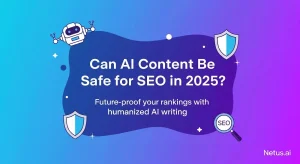
Can AI Content Be Safe for SEO in 2025? Let’s start with the question of keeping every content strategist, SEO pro and blogger awake at
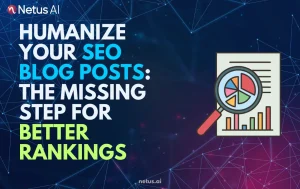
Humanize Your SEO Blog Posts: The Missing Step for Better Rankings You’ve done everything by the book. Your keyword research is impeccable. Your meta descriptions
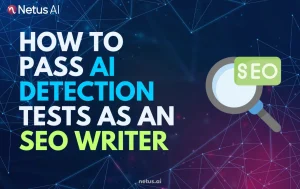
How to Pass AI Detection Tests as an SEO Writer Let’s paint a familiar picture. You’ve just finished a blog post. The headline is sharp,
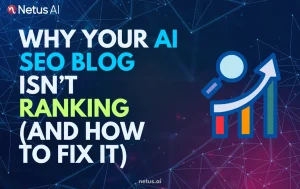
Why Your AI SEO Blog Isn’t Ranking (And How to Fix It) You embraced AI for your blog. The promise was intoxicating: high-quality content, published
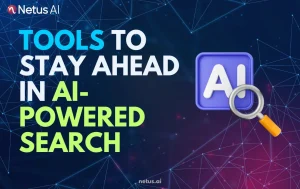
The Modern SEO Writer’s Stack: Tools to Stay Ahead in AI-Powered Search Remember the days when “SEO writing” conjured images of frantic keyword stuffing, awkward
@ 2024 Netus AI.